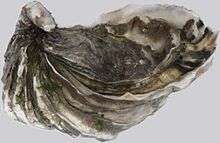Magallana
Magallana is a genus of true oysters (family Ostreidae) containing some of the most important oysters used for food. Species in this genus have been moved from Crassostrea after it was found to be paraphyletic.
| Magallana | |
|---|---|
 | |
| Pacific oyster, Magallana gigas | |
| Scientific classification | |
| Kingdom: | Animalia |
| Phylum: | Mollusca |
| Class: | Bivalvia |
| Order: | Ostreida |
| Family: | Ostreidae |
| Genus: | Magallana Salvi & Mariottini, 2016 |
| Species | |
|
See text | |
Species
Extant species
Extant species include:[1]
- Magallana ariakensis (Fujita, 1913) – Suminoe oyster[1]
- Magallana belcheri (G.B. Sowerby II, 1871)[1]
- Magallana bilineata (Röding, 1798) - Philippine cupped oyster (talabang tsinelas)[2][1]
- Magallana dactylena (Iredale, 1939)[1]
- Magallana gigas (Thunberg, 1793) (syn. C. talienwhanensis) – Pacific oyster[1]
- Magallana hongkongensis (Lam & Morton, 2003)[1]
- Magallana nippona (Seki, 1934)[1]
- Magallana rivularis (Gould, 1861)[1]
- Magallana sikamea (Amemiya, 1928) – Kumamoto oyster[1]
Genetics
The genome of Magallana gigas has been recently sequenced [3] revealing an extensive set of genes that enable it to cope with environmental stresses.
gollark: Really, if the supernatural things some dodecahedra go on about were real, there would be books like this.
gollark: Sadly, the contents do not currently exist.
gollark: I think my favourite is the Netcleaner one.
gollark: I mean, yes, those are real images stored on i.osmarks.tk.
gollark: Intelligence.
References
- Taxon list for Magallana. World Register of Marine Species, accessed on 1 March 2012.
- "Crassostrea iredalei (Faustino, 1932)". SeaLifeBase. Retrieved 15 December 2018.
- Zhang, G.; Fang, X.; Guo, X.; Li, L.; Luo, R.; Xu, F.; Yang, P.; Zhang, L.; Wang, X.; Qi, H.; Xiong, Z.; Que, H.; Xie, Y.; Holland, P. W. H.; Paps, J.; Zhu, Y.; Wu, F.; Chen, Y.; Wang, J.; Peng, C.; Meng, J.; Yang, L.; Liu, J.; Wen, B.; Zhang, N.; Huang, Z.; Zhu, Q.; Feng, Y.; Mount, A.; Hedgecock, D. (2012). "The oyster genome reveals stress adaptation and complexity of shell formation". Nature. 490 (7418): 49–54. doi:10.1038/nature11413. PMID 22992520.
This article is issued from Wikipedia. The text is licensed under Creative Commons - Attribution - Sharealike. Additional terms may apply for the media files.